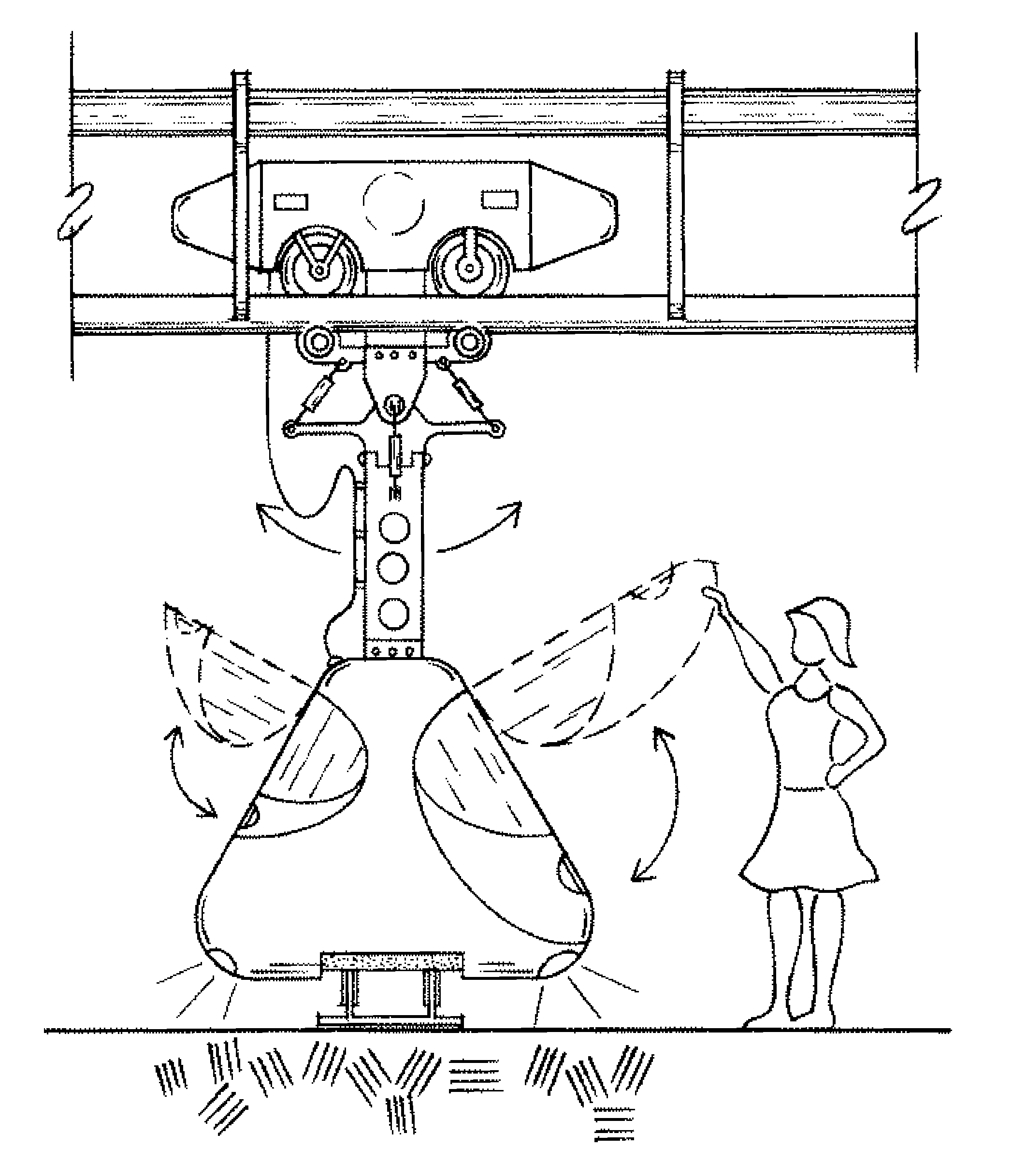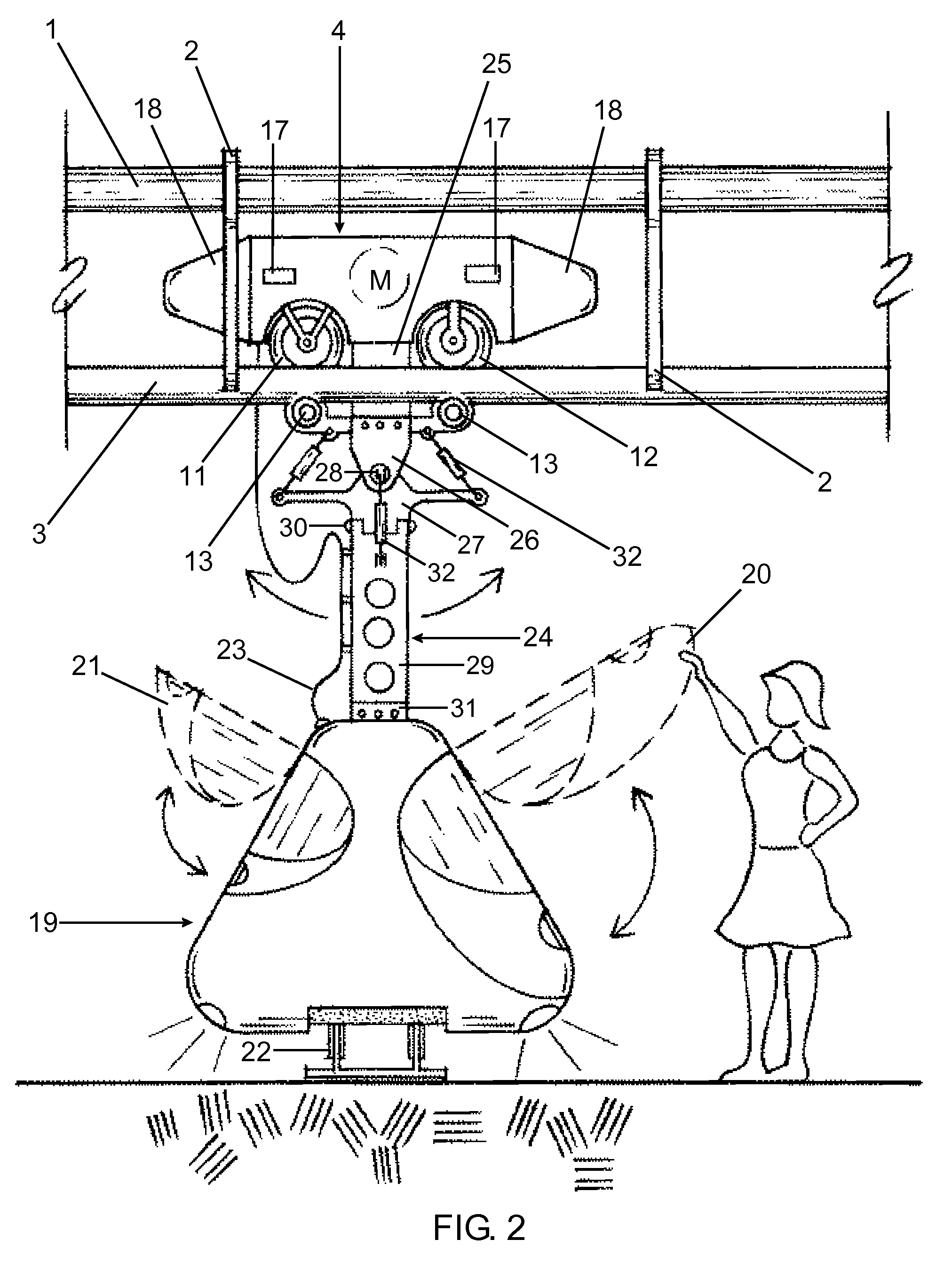[0018]Passengers and freight are transported inside a module that hangs from a propulsion dolly with in-line wheels to roll along the tracks; thus, a vehicle consists of three main parts: a propulsion dolly, a passengers or freight module and a hanger to suspended the module from the dolly. The simplest arrangement of a propulsion dolly consists of a two wheels dolly with a rear
drive wheel that provides movement and a front wheel used for direction. A dolly can have several wheels while a module can have more than one dolly to hang from as will be the case for modules with extended cabs or heavy freight loads. Propulsion is provided by one or more electric motors in the dolly that run on
electric power supplied at the tracks using a conventional railway power supply configuration and
distribution grid; however, the
system is also suited for vehicles driven by internal
combustion engines for feasible applications. Rubber bumpers attached at each end of the propulsion dollies allow the vehicles to travel bumper-to-bumper touching each other at a uniform
constant speed during
rush hour for optimal performance of the system. As the vehicles travel bumper-to-bumper touching each other at high speeds the system resembles a canning or bottling line in full operation. Passengers and freight modules can be any size and take any shape as long as they fit within the tracks boundaries and are able to
traverse the curved and inclined track sections. Vehicles are privately owned and passengers are expected to ride with the same comforts and amenities of a modern automobile. Vehicles can have movable seats so passengers can adjust them to face the forward movement or look back as the vehicle moves along the tracks.
[0019]Location markers and conventional electronic signals in the tracks along with sensors in the vehicles allow a computer
on board each vehicle to use a navigation
software to determine the exact position of a vehicle at any time and program the fastest way to a destination. The information is relayed
wireless and over cable to computers at a master control that identifies each vehicle then handles and monitors vehicular flow along the tracks networks or trackways. Once the vehicles start moving there's no need for them to stop until they reach their destination as there are no crossings along the tracks path and there's no need for track switches to
route vehicles to its destination since each vehicle has a steering mechanism. Tracks merge and split in “Y” shaped junctions and forks track sections. This configuration allows the propulsion dolly wheels to follow a continuous path from beginning to end of a programmed trip. To diverge from a track a
relay will
signal the steering mechanism of a vehicle to turn either side at forks. When vehicles merge into another track they only have to follow the track they are in while the steering mechanism remains idle. As the vehicles merge the system resembles a zipper being closed and as the vehicles diverge the system resembles a zipper being opened. The propulsion dolly motor will slow down or speed up controlled by a computer
on board each vehicle to allow the vehicles to keep on rolling and merge without colliding with each other automatically.
[0022]Since such vehicles get their power from the tracks
assembly there's no need to recharge them. A power meter and a
relay device in each vehicle communicating
wireless and over cable with a
processing center allows for automatic electronic transactions so that each vehicle owner can be charged to their account for
power consumption, tolls and vehicle registration. Batteries on each vehicle will provide for emergency power
backup. If a vehicle losses propulsion due to a malfunction it will be pushed at the bumpers by other vehicles to the next
emergency exit. In the event of an accident or
structural failure of the tracks a master control can stop all vehicles at once and redirect traffic. Vehicles can also be stopped manually from the inside of a passengers module or by using an external
emergency stop button on premises accessible to anyone as a safety measure while they move close to the ground such as when leaving or picking up passengers. Catwalks with
stairs to
ground level installed at a convenient distance one from the other allow passengers to leave their vehicles in an emergency situation when the passengers modules are high above the ground.
[0023]Accordingly it is the object of this invention to provide a personal transportation and freight
delivery system that: 1—Is easy to build, setup and operate as a
fully automated transportation system by those skilled in the art and science of
fully automated rail transportation systems using conventional
automation methods and equipment. 2—Is a reliable, safe and efficient alternative to a car and allows people to go anywhere they want using their own fully automated vehicle that moves on steel tracks and no one has to drive. 3—Is a reliable, safe and efficient alternative to a delivery
truck using fully automated vehicles that move on steel tracks and no one has to drive to deliver all sorts of goods and merchandise anywhere along the tracks. 4—Can transport a single passenger more efficiently than a car does. 5—Uses less land than streets, highways and freeways construction does. 6—Adapts easily to the existing urban outline. 7—Contributes less environmental
pollution than cars and trucks do. 8—Allows children,
older people and people with disabilities to provide their own personal transportation since no
driving skills are needed to operate such vehicles. 9—Allows passengers to carry out other activities while they go from one place to another since there's no need to drive such vehicles. 10—Have the least
moving parts subject to
wear and tear and most components are easily accessible for proper maintenance and repairs. 11—Allows vehicles to travel over obstacles including cars and pedestrians. 12—Allows vehicles to travel inside a building and into an office space or a
living space several stories
above ground. 13—Allows vehicles to travel from one building to another at any height from the ground. 14—Enables a more comfortable ride for passengers than a car does in curved and inclined path stretches.
 Login to View More
Login to View More  Login to View More
Login to View More 


